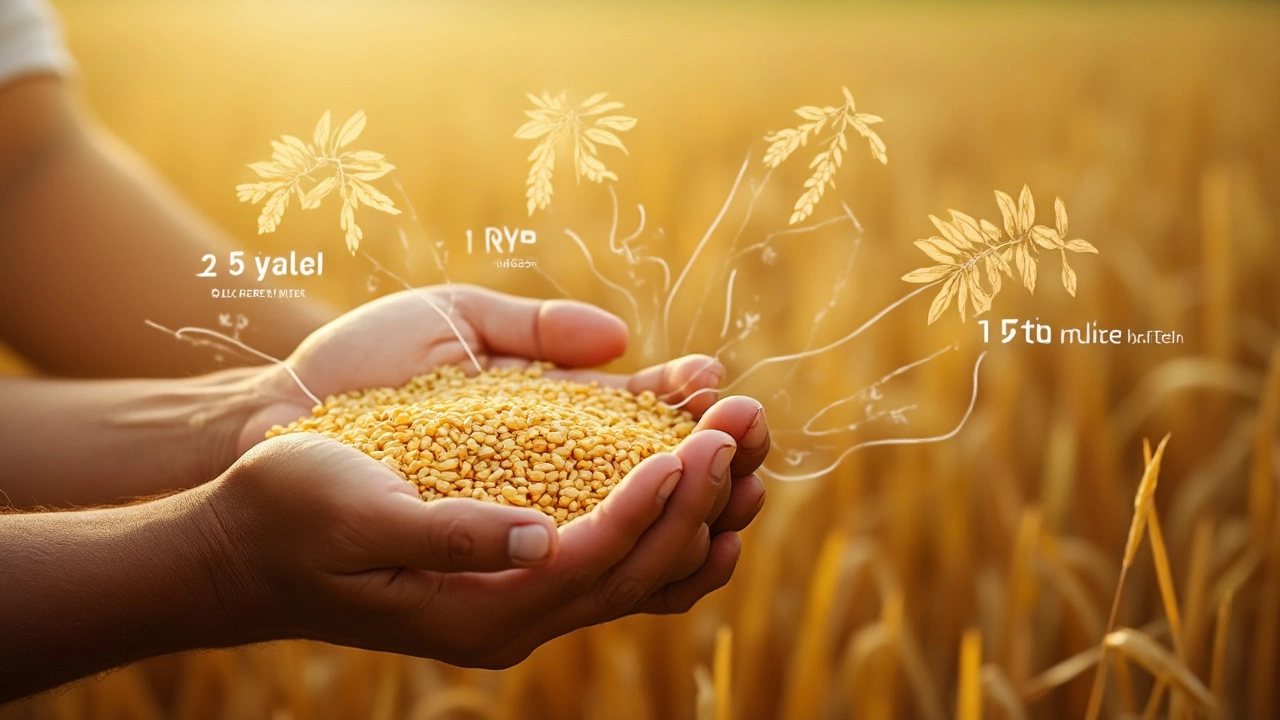Ever wonder just how much land it would take to feed a single person rice for a year? It’s a question that’s more practical than you might think—especially if you’re eyeing food self-sufficiency or just want to see how big your backyard needs to be to pull it off.
Most folks eat about 150 to 200 pounds of uncooked rice a year if rice is their main staple. Doing the math on how much land gives you that much rice is where it gets interesting. Yields vary a ton based on where you are and how you grow, but there are some real-world averages you can start from, whether you’re farming an acre or messing around with a couple of raised beds.
I’ll break down what affects your rice harvest, show you how yields compare in different places, and share a few tricks to squeeze more grain out of every square foot. Stick around if you’ve ever looked at your bowl of fried rice and thought, “How much space did this actually take to grow?”
- Rice Needs per Person: Breaking Down the Numbers
- How Much Rice per Acre: Yields You Can Expect
- Factors That Mess with Rice Yield
- Tips for Making the Most Out of Your Plot
Rice Needs per Person: Breaking Down the Numbers
If you want to know how much rice you need for the whole year, let’s start simple. On average, an adult who eats rice regularly will go through somewhere between 150 to 200 pounds of uncooked rice every year. That number assumes rice is a major part of most meals—not just an occasional side dish.
Need something even more specific? In places like Southeast Asia, where rice is the main thing on the plate, some people eat closer to 300 pounds per year. In the United States, most folks eat less—maybe closer to 25 pounds a year per person. For basic survival and energy needs, though, aiming for 150 pounds per person per year hits the sweet spot for most situations.
Here’s a quick way to see if you have your math right:
- One pound of uncooked rice is around 2.5 cups.
- One cup of uncooked rice = about three cups cooked.
- So if you eat one cup of cooked rice per meal, that’s about 120 pounds of uncooked rice yield for a year.
Of course, if your family has bigger appetites, you’ll want to bump that number up. If you’re just feeding yourself and hate wasting food, you could shave it down a bit. But if you’re storing rice for emergencies or trying to grow all your own food, start with the higher end of the estimate.
How Much Rice per Acre: Yields You Can Expect
If you’re wondering what kind of rice yield you can actually pull from an acre, here’s the straight-up info. Most commercial rice farms pull in anywhere from 5,000 to 8,000 pounds (about 2.5 to 4 tons) of rice per acre if we’re talking about paddy rice with good water and fertilizers. On smaller, low-tech setups, or in drier spots using upland rice, you’re looking at closer to 2,000 to 3,000 pounds an acre—sometimes less if conditions aren’t great.
To get a better picture, here’s a comparison of rice yields from different regions and ways of farming:
| Country/Method | Yield per Acre (pounds) |
|---|---|
| United States (mechanized flooded fields) | 7,100 - 8,000 |
| Vietnam/Thailand (traditional paddy) | 4,000 - 6,000 |
| India (mixed methods, rainfed) | 2,000 - 3,500 |
| Home gardener (no chemicals, small plots) | 1,500 - 2,500 |
Keep in mind, rice is usually harvested with its hull on. Once you remove the hull in milling—what most people actually eat—you’ll have about 65% of that original weight as edible white rice. So if you harvest 3,000 pounds in the field, you’ll end up with around 1,950 pounds of rice to eat.
Here’s what really affects your yield:
- Water: Flooded paddy fields almost always win out over dry fields.
- Variety: Modern hybrids can double the yield of some old-school types.
- Fertilizer: More nutrients, bigger harvest—if you don’t overdo it.
- Pest and weed control: Rice doesn’t stand a chance with out-of-control weeds or bugs.
- Weather: Too much rain? Not enough? Either can tank your numbers.
Bottom line: With good conditions and a little know-how, a single acre can give you way more rice than most families could eat in a year. But if you’re growing rice in your backyard or on a hobby scale, expect way less—you’d still get enough to take a big bite out of your pantry bills, though.

Factors That Mess with Rice Yield
Not all rice paddies are created equal, and there’s no magic trick to guarantee a bumper crop. Loads of stuff gets in the way, from unpredictable weather to soil that just won’t cooperate. Here’s a straight-up look at what really cranks up or drags down your rice harvest.
- Water Control: Rice loves water, but too much or too little can trash your field. Flooding keeps out weeds but drains and levees better be solid. Drought, on the other hand, just ruins yields fast.
- Soil Quality: Your rice isn’t going anywhere without healthy, nutrient-rich dirt. Acidic soil or one packed with salt kills off roots and drops your yield. Adding compost or just rotating with other crops helps keep dirt in good shape.
- Pests and Disease: Birds snacking in your field, bugs munching the plants, or diseases like rice blast can burn through your harvest. Fungicides and bug management help, but sometimes you just lose a chunk of your crop.
- Seed Variety: Not all rice seeds are equal. High-yield hybrid seeds, like IR64, can double the amount you get compared to the old-school stuff—if the field conditions are right.
- Weather: Rice needs warm temps, around 25-35°C (that’s 77-95°F), and the growing season has to be long enough. Too much wind or cold snaps, and you’re left with empty stalks.
- Fertilizer Game: Rice is a heavy feeder. Skimp on nitrogen, phosphorus, or potassium, and you’re looking at thin, scrawny plants. But overdo chemicals and you get pollution or weak stalks that fall over in the rain.
Just to make things real, check out the actual rice yields in different places:
| Country/Region | Average Yield (tons/acre) |
|---|---|
| United States | 3.1 |
| India | 1.1 |
| China | 2.7 |
| Southeast Asia (average) | 1.3 |
The difference boils down to water access, know-how, seed choice, and how much work you put in. Bottom line: if you want the best rice yield, you’ve got to keep these factors in check. Mess up even one, and your bowl could be looking a little empty when harvest rolls around.
Tips for Making the Most Out of Your Plot
If you’re thinking one acre is already a lot to handle, don’t worry—you can still get good results even with less space if you know a few hacks. Here’s what I’ve picked up from growers who get the most bang for their buck (and grain for their plate):
- Rice cultivation loves water, so if you’ve got low-lying land or a patch you can flood, use it to your advantage. Flooding is old-school and effective for controlling weeds and boosting yield. Even if you can’t flood, keeping soil consistently damp makes a big difference.
- Don’t sleep on good soil. Throw in well-rotted manure or compost before planting. Rice needs a fair bit of nitrogen, so a yearly boost keeps those plants lush and productive. Bagged fertilizer works in a pinch—aim for something with a balanced N-P-K ratio.
- Spacing matters. Cramming in seedlings might look clever but it actually reduces yield. Aim for 8 to 10 inches between each plant. This lets sunlight hit every stem and makes it way easier to weed or check for bugs.
- Keep weeds out, especially during the first month. Mulch can help cut down on weed woes, or just make a habit of pulling them early and often. Weeds steal water and nutrients, and rice doesn’t have a lot to spare.
If you live somewhere with shorter summers or cooler temps, hunt down early-maturing or cold-tolerant rice varieties. Japanese "Koshihikari" is a hit in cooler climates, while "Carolina Gold" does well in the southern U.S. Always check what’s grown locally for best odds.
One thing I always notice: the most successful backyard growers keep a log of what they do each season. It sounds like a hassle, but jotting down how much you plant, when you water, and what goes wrong helps you tweak things year to year. You’ll spot your own patterns way faster than by guessing.
Bottom line—every plot is different, but with the right tricks and a bit of trial and error, you can squeeze surprisingly big rice harvests out of spaces most people overlook.

